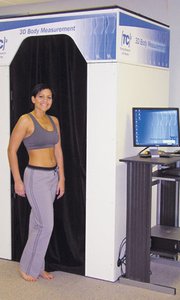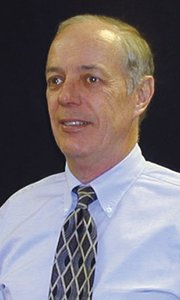Think Tank: [TC]2's 3-D Body Scanner
[TC]2's 3-D body scanner is just one of the research firm's innovations
[TC]2 spent eight years developing a 3-D body scanner used by Brooks Brothers and other leading apparel companies. That long development process was only possible because Cary, North Carolina–based [TC]2 (pronounced “TC Squared”) is a government-funded research firm dedicated to pioneering technology for the apparel industry.
The California Apparel News spoke with [TC]2’s director of industry programs, Jim Lovejoy, about trends in the apparel industry, how technology is addressing them, why designers take too long, and how companies can be more like Spanish fast-fashion expert Zara.
CAN: What is [TC]2, and what does it do?
JL: [TC]2 was founded in 1981 with a National Science Foundation grant to perform research on behalf of the soft-goods industry. It has gradually migrated into a research firm—rather than developing attachments for sewing machines and things like that—more towards future technology. We have also migrated into education and are teaching the industry how to use research, new software, computer-control tools like cutting machines, so that means consulting, too.
We’re supported by the industry, so members pay dues and get priority access to our activities, and we are also partially supported by a Department of Congress grant to perform research. But that is temporarily out because of the big fuss in Washington about earmarks—things that get stuck in bills at the last moment that some people call pork but is the way they fund small projects. The industry is under such duress that helping it to be more competitive with research is very useful.
CAN: If you had to, could you change to a private model?
JL: Typically the grant was 45 percent of our revenue, so it would be a significant hit. Some of the research we’ve been chartered to do was research a company wouldn’t undertake because it was too risky or too expensive. For example, the 3-D body scanner we developed took eight years; a company that was for-profit without some kind of subsidy wouldn’t think that was a very good deal because it may never be profitable when you factor in expenses.
CAN: What comprises your staff?
JL: We have 38 people. It’s about one-third engineers, one-third manufacturing consultants, and one-third administrative, programmers, etc.
CAN: You said the industry is in a state of duress. What did you mean?
JL: That was part of the original idea for doing research, because most companies were focused on trying to get costs down. So “under duress” means in terms of employment—in that manufacturers potentially had to move their plants to where labor was cheaper. So there isn’t a lot of manufacturing left: Probably 80 percent of apparel has left the country. And of course in Washington they’ve been encouraging that, starting with free-trade agreements like NAFTA and the World Trade Organization opening up to China.
CAN: Is your research intended to help the United States keep jobs?
JL: The idea is to keep companies competitive. Where they put the work is up to them. We could come out with a new device that makes it more productive to do product development in the United States, but someone could decide to put it in Singapore or Hong Kong if they wanted to.We’ve been putting a lot of emphasis on product development because that’s the slowest part of the cycle.
CAN: And we certainly live in an age of hyper-consumerism where people want constant novelty.
JL: Yes, the four seasons have gone by the wayside, and most retailers are trying to bring in new merchandise as fast as they can. The difficulty in doing that is if the stuff you have hasn’t sold yet, there may not be room on the shelf. And a lot of places like to do collections, but there have been some renegade retailers demanding fast fashion who say fast is more important than waiting for a collection or season.
Zara in Spain ships stuff to the stores once or twice a week, so they get customers coming in a lot more frequently. They also don’t make a whole lot of anything, so in most cases it doesn’t go on sale. It’s kind of got everyone’s attention, saying, “Okay, that’s a different culture because they’re vertical and can control the fabric and dyeing, finishing and cutting, and only farm out the sewing. So they can change very quickly, and most places aren’t set up to do that. But there are lessons to be learned about how to cut a month or several weeks out of the cycle.
CAN: Have you officially studied Zara?
JL: We do seminars on them. We did one at FIDM in Los Angeles in collaboration with a consultant who’s worked directly with Zara and its suppliers.
CAN: What are the lessons U.S. companies can learn from Zara?
JL: Controlling the supply chain and speeding up product development. The anecdotal evidence is that designers take too long, and a lot of it is “I’ve got to go do some research; I may have to go to Paris; I want to check all the competition.” There’s a lot of research, and then they say, “Okay, this is what I think.” Instead of just doing one thing, they put out a whole line, and it takes a long time to put all that together.
At Zara they have a team of 200 designers. There’s no one person; they build a consensus. The people who make the samples are right there on the same floor. So samples are made, they try it out, and get a decision very quickly—in days. In traditional product development there’s a six-month calendar with reviews on a weekly or monthly basis. The work might be finished on Tuesday, but you wait until your Friday meeting so the executive can say “go ahead.”
We do the same thing in manufacturing: Empower the team to make the decisions, rather than have a supervisor come over and review what’s been done.
CAN: How can technology help companies be more like Zara?
JL: Zara doesn’t have a lot of technology. They use their own in-house systems and do what they do through their business culture and process, driving the calendar and setting the priorities. Most companies will say, “We want to get the product right.” You can fool around, analyze, and research to get the product right. Zara doesn’t really care about that.
But if you take the technology approach, you can scan a fit model or buy some of the data we have from our national survey in which we scanned 10,000 people, and with the software you can predefine a garment with ease for each of the measurements, such as waist and hips and things like bell bottoms. You take the body scan and it generates a 2-D pattern that goes into the CAD system that finishes off the pattern. Then that can be sent electronically to a factory where it can get cut and sewn very quickly.
Software is getting very sophisticated as far as being able to portray what a garment will look like on a person, so that can take the place of a fit session. And with video conferencing, you can see how a garment will fit on a mannequin so you don’t have to have the sample flown back and forth making four or five samples because it doesn’t fit right.
CAN: You’re suggesting a future in which clothing is very much made to measure.
JL: We see an increasing interest in custom clothes. There’s a company called Archetype Solutions that took some of our data and made common models of people based on body shape, because not everybody’s shaped like the fit model. Archetype Solutions has added the capability to Lands’ End, Target, and JC Penney so that online you can order a custom shirt that costs 40 percent more and you get it in a few weeks. I’ve done it and they fit nice. You measure yourself, and they base it on their models. So they have someone who’s close to me and use that to fill in the rest of the measurements.
Lands’ End started doing this with chinos, and in a year and a half it had built up to be 40 percent of their online sales.
Brooks Brothers has been in the custom clothing business for years. They have expert tailors to take measurements, but they also have two of our scanners that have cut their alterations expenses like 75 percent because they get a much bigger hit on the first fit being right.
CAN: What can people buy from [TC]2?
JL: We make the scanner along with the software. It’s $35,000. The newest model fits inside a retail dressing room, because for a long time people said it took up too much floor space.
We also have a digital print area where we’re experimenting with printing where everything matches up when you cut it: You don’t have to worry about orienting the pattern on the fabric.
CAN: And people can hire you as consultants?
JL: That’s our primary business. We’ve done projects looking at companies’ plants and product development, and how to get lean, because everybody’s thinking about speed to market.
CAN: What advice do you have for a smaller company that wants to improve its speed to market but doesn’t have a lot of money to spend on technology?
JL: A lot of times it’s just the way the work flows. Our consultants will do an assessment and typically visit a plant for two or three days and look at the work flow, and then write a report. Typically a lot of things we suggest can be done by the companies themselves, then we also give a list of things we can do for them.
CAN: What’s your consulting rate?
JL: Usually two people go for a flat fee of $5,000. The time we get calls are when somebody has been running a small business for a while and all of a sudden starts to grow and can’t handle the work. Rather than hire more people, buy more machines, and rent more space, they say, “Let’s see if we can be more efficient with what we have.”
We also offer classes in patternmaking and apparel manufacturing. We think retailers are hiring people out of college who have degrees in design and merchandising but who aren’t getting the technical side of the business.























